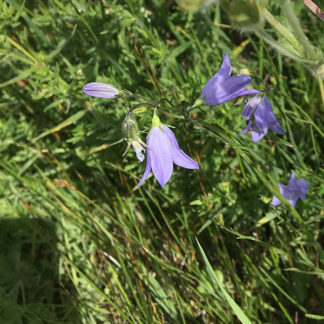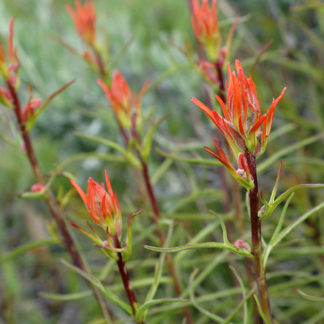late summer
Showing 13–24 of 134 results
-

Artemisia ludoviciana / white sage
- low, spreading perennial - up to 3 feet tall
- silvery leaves and stems (hairy)
- leaves lance shaped, but sometimes lobed
- shoots die back in winter
- aromatic
-

Artemisia tridentata / mountain big sagebrush
- medium-sized grey-green shrub
- highly aromatic
- tall, spikey inflorescences with many clusters of invisible flowers
- limited to drier habitats (not the Valley basin)
-

Artemisia tripartita / threetip sagebrush
- evergreen shrub; branches in broom-like clusters
- all parts covered with silvery/grey-green glandular hairs
- leaves long and very deeply, very distinctly 3-lobed
- flowers in spikes/racemes - all bits teeny, overall yellow-ish/reddish
- often with mountain big sagebrush on nutrient poor soils
-

Bassia scoparia / burningbush
- large, annual herb (forb)
- leaves long-ish and narrow
- inflorescence a highly branched spike with teeny green/yellow flowers
- may form huge, invasive colonies
- whole plant turns red in fall
- a tumbleweed
- especially in disturbed areas and wastelands in the Valley
-

Bromus inermis / smooth brome
- clump forming grass but clonally spreading
- erect, leafy
- in winter, leaves curl up (like ribbon)
- florescence is a nodding panicle, standing well above leaves
- spikelets bronze/purple at maturity; anthers yellow
-

Campanula rotundifolia / American harebell
- blue or blue-ish bell-shaped flower
- fused petals with pointy ends make the bell
- exudes white latex when wounded
-

Carduus nutans / musk thistle
- quite large, very purple flower heads
- spiny everything... leaves, stems, bracts
- biennial - large rosette of nasty leaves in first year
- dandelion-like fruit that flies away like the down of a thistle
- disturbed lands... pastures, wastelands, roadsides, construction sites
-

Castilleja linariifolia / Wyoming Indian paintbrush
- generally taller than most paintbrushes (up to 3 feet)
- very thin leaves, seldom lobed, seldom hairy
- red inflorescence bracts, may be lobed
- flowers extend well beyond bracts
- calyx is red and shorter than the corolla which is greenish yellow
- rocky areas with sagebrush and conifer forests
-

Castilleja spp. / paintbrushes
- vibrant, red (or yellow) inflorescence (bracts)
- widespread, but confusing... five or more species in the area
-

Castilleja spp. / two yellow paintbrushes
- look like Indian paintbrushes (which they are), but yellow
- inflorescence bracts possibly lobed
- height ranges from less than 8" to about 15"
- subalpine, alpine and tundra habitats, in clumps or spread out
- linear leaves without lobes, 3 prominent veins
- red to maroon, hairy stems
-

Centaurea maculosa / spotted knapweed
- "vibrant" pink flowers
- dark tips on the sepals ("bud scales") - the "spotted" in the name
- biennial - rosette of leaves in first year
- officially a noxious weed
-

Chaenactis douglasii / Douglas dusty maiden
- leaves "woolly" or hairy; intricately divided
- leaf and lobe tips curled or twisted
- flowering stems coated with "cobwebby" hairs
- flower heads of white/pinkish tubular disk florets in a glandular cup
- forked styles protrude past tubes
- often in rocky areas and crevices
Showing 13–24 of 134 results